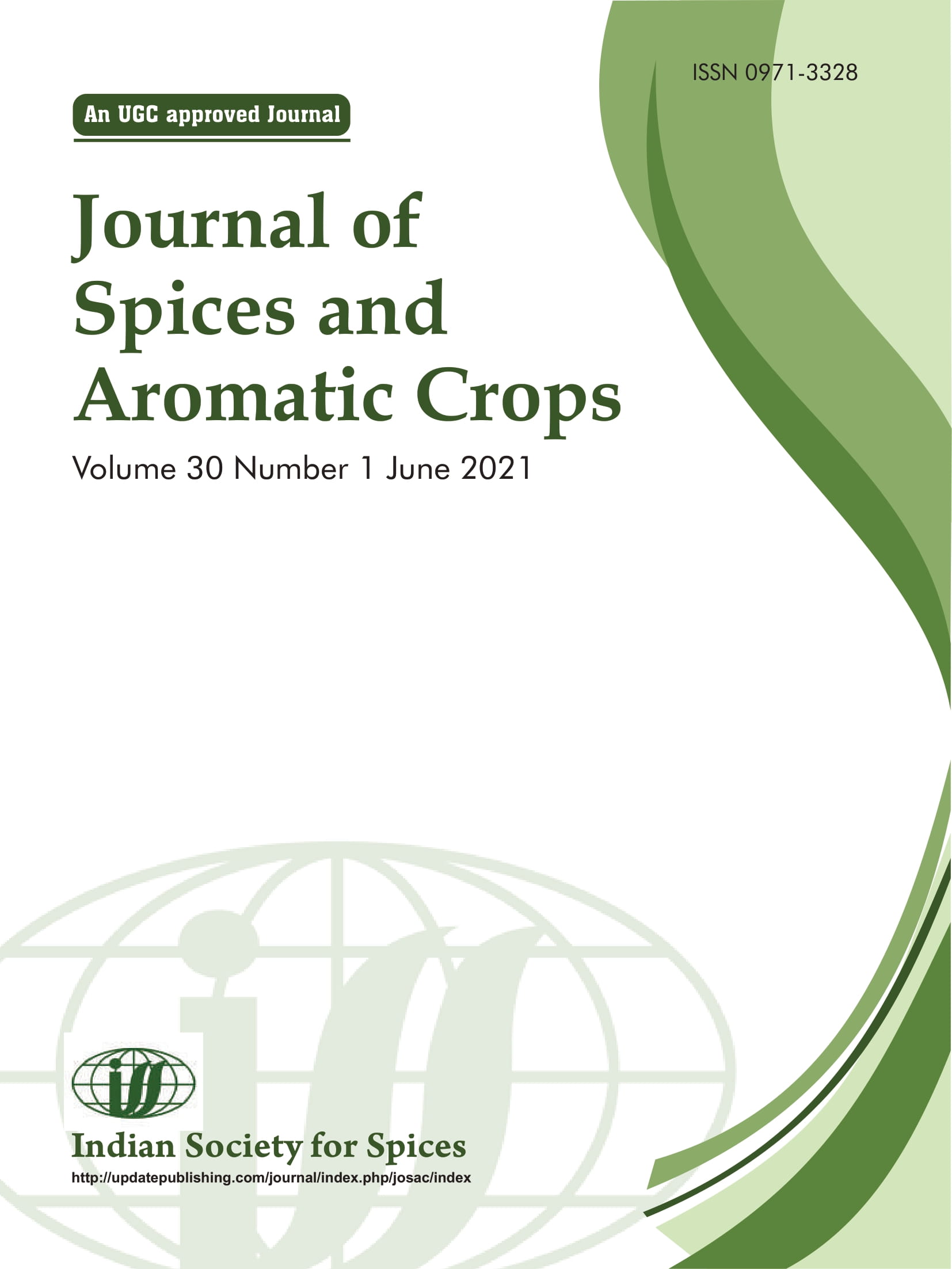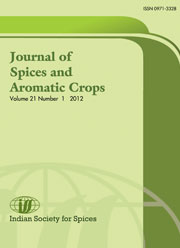Biocontrol of Pythium aphanidermatum causing soft rot in ginger with biosurfactant produced by a rhizospheric Bacillus species
Biocontrol of Pythium aphanidermatum with biosurfactant
DOI:
https://doi.org/10.25081/josac.2021.v30.i1.6586Keywords:
Bacillus altitudinis VS7, biocontrol, biosurfactant, plant probiotics, Pythium aphanidermatum, rhizobacteriaAbstract
Plant growth-promoting rhizobacteria benefit plants by producing phytohormones and acquiring vital nutrients from soil. They also form a shield against potential phytopathogens with the production of antimicrobial compounds such as bacteriocin, biosurfactants etc. In the present study, among various rhizobacteria isolated from ginger rhizosphere, the isolate identified as Bacillus altitudinis VS7 that showed a potent biosurfactant producing ability in the preliminary tests was selected for the further study. Compositional analyses indicated that the biosurfactant produced by VS7 was a surfactin like compound, a cyclic lipopeptide. In both microtitre plate and mycelium growth inhibition studies, the biosurfactant showed dose dependent antagonistic activities against Pythium aphanidermatum that causes soft rot in ginger. Although there are reports of biocontrol activity of various rhizobacteria against soft rot in ginger, this is the firstinformation regarding biocontrol activity of a biosurfactant produced by the rhizobacterium B. altitudinis VS7 against P. aphanidermatum.
Downloads
References
Banat I M 1995 Biosurfactants production and possible uses in microbial enhanced oil recovery and oil pollution remediation: a review. Bioresour. Technol. 51: 1–12.
Bazzicalupo M & Fani R 1996 The use of RAPD for generating specific DNA probes for microorganisms. Methods Mol. Biol. 50: 155-175.
Bhai R S, Kishore V K, Kumar A, Anandaraj M & Eapen S J 2005 Screening of rhizobacterial isolates against soft rot disease of ginger (Zingiberofficinale Rosc.). JOSAC. 14: 130–136.
Borah S N, Goswami D, Sarma H K, Cameotra S S & Deka S 2016 Rhamnolipid Biosurfactant against Fusarium verticillioides to Control Stalk and Ear Rot Disease of Maize. Front. Microbiol. 7: 1505.
Dake G N & Edison S 1989 Association of pathogens with soft rot of ginger in Kerala. Indian Phytopathol. 42: 116–119.
Felsenstein J 1985 Confidence limits on phylogenies: An approach using the bootstrap. Evolution. 39: 783-791.
Feofiloa E P, Sergeeva Y E, Mysyakina I S & Bokareva D A 2015 Lipid composition in cell walls and in mycelial and spore cells of mycelial fungi. Microbiology. 84: 170-176.
Gosal S K, Kaur J, Kaur J 2017 Plant Growth-Promoting Rhizobacteria: A Probiotic for Plant Health and Productivity. In: Kumar V, Kumar M, Sharma S, &Prasad R (Eds.) Probiotics and Plant Health. Springer, Singapore. https://doi.org/10.1007/978-98110-3473-2_27.
Goswami D, Borah S N, Lahkar J, Handique P J & Deka S 2015 Antifungal properties of rhamnolipid produced by Pseudomonas aeruginosa DS9 against Colletotrichum falcatum. J. Basic Microbiol. 55: 1265– 1274.
Goswami D, Handique P J & Deka S 2014 Rhamnolipid biosurfactant against Fusarium sacchari—the causal organism of pokkahboeng disease of sugarcane. J. Basic Microbiol. 54: 548-557.
Goswami M & Deka S 2019 Biosurfactant production by a rhizosphere bacteria Bacillus altitudinis MS16 and its promising emulsification and antifungal activity. Colloids Surf. B. 178: 285-296.
Gudina E J, Rocha V, Teixeira J A & Rodrigues L R 2010 Antimicrobial and antiadhesive properties of a biosurfactant isolated from Lactobacillus paracaseissp. paracaseiA20. Lett.Appl. Microbiol. 50: 419-424.
Jain D K, Collins-Thompson D L, Lee H & Trevors J T 1991 A drop-collapsing test for screening surfactant-producing microorganisms. J. Microbiol. Methods. 13: 271-279.
Kavitha P G & Thomas G 2007 Evaluation of Zingiberaceae for resistance to ginger soft rot caused by Pythium aphanidermatum (Edson) Fitp. Plant Gent. Resorc. News Lett.152: 54-57.
Kumar S, Dubey R C & Maheshwari D K 2016 Biosurfactant-Mediated Biocontrol of Macrophomina phaseolina Causing Charcoal Rot in Vigna mungo by a Plant Growth Promoting Enterococcus sp. BS13. J. Plant Pathol. Microbiol. 7: 385.
Le D P, Smith M, Hudler G W & Aitken E 2014 Pythium soft rot of ginger: Detection and identificationof the causal pathogens, and their control. Crop Prot. 65: 153-167.
Mahanta J & Samajdar T 2013 Diseases of Ginger, Krishi Vigyan Kendra, Tura, Meghalaya.
Malfanova N, Kamilova F, Validov S H, Shcherbakov A, Chebotar V, Tikhonovich I & Lugtenberg B 2011 Characterization of Bacillus subtilis HC8, a novel plant-beneficial endophytic strain from giant hogweed. Microb. Biotechnol. 4: 523–532.
Mallick S K, Chakraborty S 2019 Bioremediation of wastewater from automobile service station in anoxic-aerobic sequential reactors and microbial analysis. Chem. Eng. J. 361: 982-989.
Mangoni M L & Shai Y 2011 Short native antimicrobial peptides and engineered ultrashort lipopeptides: similarities and differences in cell specificities and modes of action. Cell Mol. Life Sci. 68: 2267.
Nayarisseri A, Singh P & Singh S K 2018 Screening, isolation and characterization of biosurfactant producing Bacillus subtilis strain ANSKLAB03. Bioinformation. 14: 304-314.
Ongena M, Jacques P, Toure Y, Destain J, Jabrane A & Thonart P 2005 Involvement of fengycin-type lipopeptides in the multifaceted biocontrol potential of Bacillus subtilis. Appl. Microbiol. Biotechnol. 69: 29–38.
Pathak K V & Keharia H 2013 Characterization of fungal antagonistic bacilli isolated from aerial roots of banyan (Ficus benghalensis) using intact-cell MALDI-TOF mass spectrometry (ICMS). J. Appl.Microbiol. 114:1300-1310.
Pathak K V & Keharia H 2014 Identification of surfactins and iturins produced by potent fungal antagonist, Bacillus subtilis K1 isolated from aerial roots of banyan (Ficus benghalensis) tree using mass spectrometry. 3 Biotech. 4: 283–295.
Raghavan D, Muthuswamy A, Kumar A, Bini Y K, Subila K P & Aravind R 2015 Isolation, characterization and evaluation of multi-trait plant growth promoting rhizobacteria for their growth promoting and disease suppressing effects on ginger. Microbiol. Res. 173: 34-43.
Rahman P K S M & Gakpe E 2008 Production, characterization and applications of biosurfactants-review. Biotechnol. 7: 360-370.
Sarma Y R 1994 Rhizome rot disease of ginger and turmeric. In: Chadha K L & Rethinam P (Eds.) Advances in Horticulture. Plantation and Spices Crops, Part-2 (pp. 1113-1138). Malhotra Publication House, New Delhi.
Sarwar A, Brader G, CorrettoE, Aleti G, Abaidullah M, Sessitsch A & Hafeez F Y 2018 Qualitative analysis of biosurfactants from Bacillus species exhibiting antifungal activity. PLoS One. 13: e0198107.
Shekhar S, Sundaramanickam A & Balasubramanian T 2015 Biosurfactant Producing Microbes and their Potential Applications: A Review. Crit. Rev. Env. Sci. Tec. 45: 1522-1554.
Sumbhe A & Tomar A 2015 Symbiotic organisms: Key for plant growth promotion. International Journal of Science, Engineering and Technology Research (IJSETR). 4: 4.
Tamura K & Nei M 1993 Estimation of the number of nucleotide substitutions in the control region of mitochondrial DNA in humans and chimpanzees. Mol. Biol. Evol. 10: 512-526.
Thivaharan V & Vytla R M 2013 Production of a Lipopeptide Biosurfactant by a Novel Bacillus sp. and Its Applicability to Enhanced Oil Recovery. ISRN. Microbiology. 2013: Article ID 621519, 8 pages.
Viramontes-Ramos S, Portillo-Ruiz M C, Ballinas-Casarrubias M D L, Torres-Munoz J V, Rivera-Chavira B E & Nevarez-Moorillon G V 2010 Selection of biosurfactant/bioemulsifier producing bacteria from hydrocarbon contaminated soil. Braz. J. Microbiol. 41: 668-675.
Walter V, Syldatk C & Hausmann R 2010 Screening concepts for the isolation of biosurfactant producing microorganisms. Adv. Exp. Med. Biol. 672: 1-13.
Published
How to Cite
Issue
Section
Copyright (c) 2021 D Goswami, M B Syiem

This work is licensed under a Creative Commons Attribution-NonCommercial-NoDerivatives 4.0 International License.









 .
.